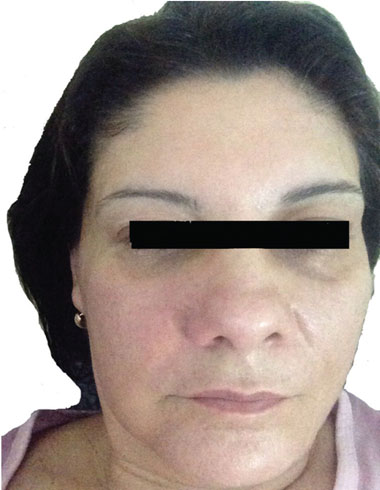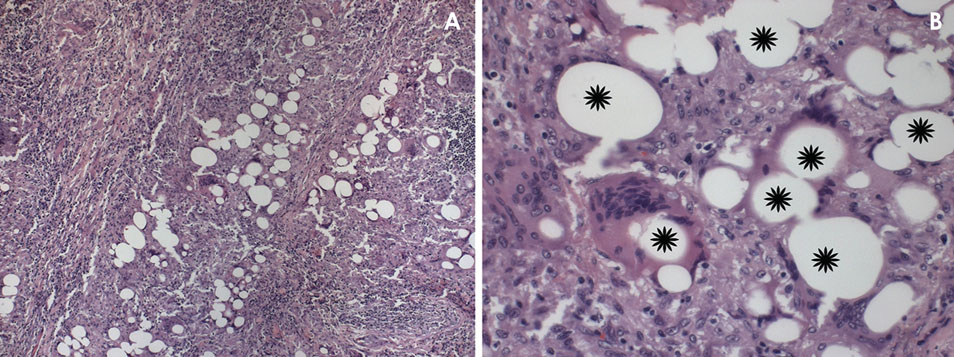Imaging Sci Dent.
2017 Dec;47(4):281-284. 10.5624/isd.2017.47.4.281.
Magnetic resonance imaging appearance of foreign-body granulomatous reactions to dermal cosmetic fillers
- Affiliations
-
- 1Department of Radiology and Orthodontics, School of Dentistry, University City of Sao Paulo, Sao Paulo, Brazil.
- 2Division of Oral and Maxillofacial Pathology, Department of Stomatology, School of Dentistry, University of Sao Paulo, Sao Paulo, Brazil.
- 3Division of General Pathology, Department of Stomatology, School of Dentistry, University of Sao Paulo, Sao Paulo, Brazil. pbraz@usp.br
- 4Division of Radiology, Department of Stomatology, School of Dentistry, University of Sao Paulo, Sao Paulo, Brazil.
- 5Laboratory of Virology, Institute of Tropical Medicine of Sao Paulo, University of Sao Paulo, Sao Paulo, Brazil.
- KMID: 2397844
- DOI: http://doi.org/10.5624/isd.2017.47.4.281
Abstract
- Foreign body granulomas can develop after the injection of various cosmetic filling materials into the facial area to flatten wrinkles. Clinically, reactive lesions are easily mistaken for soft-tissue neoplasms or cysts. This report presents a case of foreign body granuloma in a 52-year-old female patient complaining of a painless swelling in the nasolabial region. Both clinical and histological features are described, underscoring the diagnostic role of magnetic resonance imaging findings.
Figure
Reference
-
1. Di Girolamo M, Mattei M, Signore A, Grippaudo FR. MRI in the evaluation of facial dermal fillers in normal and complicated cases. Eur Radiol. 2015; 25:1431–1442.
Article2. Vargas-Machuca I, González-Guerra E, Angulo J, del Carmen Fariña M, Martin L, Requena L. Facial granulomas secondary to Dermalive microimplants: report of a case with histopathologic differential diagnosis among the granulomas secondary to different injectable permanent filler materials. Am J Dermatopathol. 2006; 28:173–177.3. Ginat DT, Schatz CJ. Imaging features of midface injectable fillers and associated complications. AJNR Am J Neuroradiol. 2013; 34:1488–1495.
Article4. Shahrabi Farahani S, Sexton J, Stone JD, Quinn K, Woo SB. Lip nodules caused by hyaluronic acid filler injection: report of three cases. Head Neck Pathol. 2012; 6:16–20.
Article5. Tal S, Maresky HS, Bryan T, Ziv E, Klein D, Persitz A, et al. MRI in detecting facial cosmetic injectable fillers. Head Face Med. 2016; 12:27.
Article6. Shahrabi-Farahani S, Lerman MA, Noonan V, Kabani S, Woo SB. Granulomatous foreign body reaction to dermal cosmetic fillers with intraoral migration. Oral Surg Oral Med Oral Pathol Oral Radiol. 2014; 117:105–110.
Article7. Lee JM, Kim YJ. Foreign body granulomas after the use of dermal fillers: pathophysiology, clinical appearance, histologic features, and treatment. Arch Plast Surg. 2015; 42:232–239.
Article8. Kawamura JY, Domaneschi C, Migliari DA, Sousa SO. Foreign body reaction due to skin filler: a case report. Oral Surg Oral Med Oral Pathol Oral Radiol Endod. 2006; 101:469–471.
Article9. Bentkover SH. The biology of facial fillers. Facial Plast Surg. 2009; 25:73–85.
Article10. Jham BC, Nikitakis NG, Scheper MA, Papadimitriou JC, Levy BA, Rivera H. Granulomatous foreign-body reaction involving oral and perioral tissues after injection of biomaterials: a series of 7 cases and review of the literature. J Oral Maxillofac Surg. 2009; 67:280–285.
Article11. Ficarra G, Mosqueda-Taylor A, Carlos R. Silicone granuloma of the facial tissues: a report of seven cases. Oral Surg Oral Med Oral Pathol Oral Radiol Endod. 2002; 94:65–73.
Article12. Razek AA, Huang BY. Soft tissue tumors of the head and neck: imaging-based review of the WHO classification. Radiographics. 2011; 31:1923–1954.
Article13. Abdel Razek AA. Computed tomography and magnetic resonance imaging of lesions at masticator space. Jpn J Radiol. 2014; 32:123–137.
Article14. Grippaudo FR, Di Girolamo M, Mattei M, Pucci E, Grippaudo C. Diagnosis and management of dermal filler complications in the perioral region. J Cosmet Laser Ther. 2014; 16:246–252.
Article15. Josse G, Haftek M, Gensanne D, Turlier V, Mas A, Lagarde JM, et al. Follow up study of dermal hyaluronic acid injection by high frequency ultrasound and magnetic resonance imaging. J Dermatol Sci. 2010; 57:214–216.
Article
- Full Text Links
- Actions
-
Cited
- CITED
-
- Close
- Share
- Similar articles
-
- Atypical Facial Filler Granuloma: Comparative Histologic Analysis with Paraffinoma
- Obstructive Sialadenitis associated with Injectable Facial Fillers
- Radiographic study of dermal fillers in the facial area: A series of 3 cases
- Foreign Body Granulomas after the Use of Dermal Fillers: Pathophysiology, Clinical Appearance, Histologic Features, and Treatment
- Late-Onset Complication of Fillers: Paraffinoma of the Lower Eyelids Clinically Mimicking Xanthelasma




